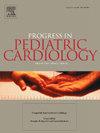Guideline-directed medical therapy for dilated cardiomyopathy in the era of pediatric ventricular assist devices: Improving transplant-free survival
IF 0.6
Q4 PEDIATRICS
引用次数: 0
Abstract
Background
Cardiomyopathy remains the leading cause of transplantation in children greater than one year of age, with low five-year transplant free survival. Despite these poor outcomes, the potential for myocardial recovery in pediatric dilated cardiomyopathy (DCM) has long been reported. In the current era of guideline directed medical therapy (GDMT), however, achievement of myocardial recovery has not been rigorously studied. Ventricular assist devices (VADs) can also be employed as a bridge to recovery, but VAD explants for recovery are rare.
Aims of review
A focus of the Sixth International Conference on Childhood Cardiomyopathy was achievement of myocardial recovery in the era of GDMT and VADs. Key questions included: (1) what is the potential for myocardial recovery; (2) what role does GDMT play in achieving myocardial recovery; (3) can durable left ventricular assist devices (LVADs) be a reasonable means to achieving recovery; (4) how do rates of recovery compare between GDMT and LVADs; and (5) what are the next steps in improving rates of myocardial recovery? This review aims to answer these questions by providing a summary of the existing literature.
Key scientific concepts of review
The future directions for pediatric DCM are to use GDMT and VADs as complementary therapies to improve not only survival to transplant, but to assess for recovery parameters so that more can be learned about the potential for transplant-free survival in patients supported by VAD and GDMT.
小儿心室辅助装置时代的扩张型心肌病指导性药物治疗:提高无移植生存率
背景心肌病仍然是一岁以上儿童接受移植的主要原因,其五年无移植存活率很低。尽管治疗效果不佳,但小儿扩张型心肌病(DCM)的心肌恢复潜力却早有报道。然而,在目前指导性医疗疗法(GDMT)的时代,心肌恢复的实现还没有得到严格的研究。第六届儿童心肌病国际会议的重点是在 GDMT 和 VAD 时代实现心肌恢复。关键问题包括(1) 心肌恢复的潜力有多大;(2) GDMT 在实现心肌恢复中扮演什么角色;(3) 耐用的左心室辅助装置 (LVAD) 能否成为实现恢复的合理手段;(4) GDMT 和 LVAD 的恢复率如何比较;以及 (5) 提高心肌恢复率的下一步是什么?本综述旨在通过对现有文献进行总结来回答这些问题。综述的主要科学概念小儿 DCM 的未来发展方向是将 GDMT 和 VAD 作为辅助疗法,不仅提高移植存活率,而且评估恢复参数,以便更多地了解 VAD 和 GDMT 支持下的患者无移植存活的潜力。
本文章由计算机程序翻译,如有差异,请以英文原文为准。
求助全文
约1分钟内获得全文
求助全文
来源期刊

PROGRESS IN PEDIATRIC CARDIOLOGY
PEDIATRICS-
CiteScore
0.90
自引率
11.10%
发文量
69
审稿时长
75 days
期刊介绍:
Progress in Pediatric Cardiology is an international journal of review presenting information and experienced opinion of importance in the understanding and management of cardiovascular diseases in children. Each issue is prepared by one or more Guest Editors and reviews a single subject, allowing for comprehensive presentations of complex, multifaceted or rapidly changing topics of clinical and investigative interest.
 求助内容:
求助内容: 应助结果提醒方式:
应助结果提醒方式:


